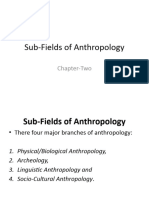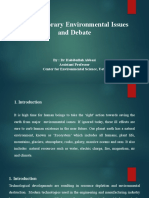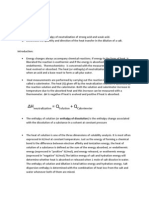Sedimentary Rock
Sedimentary Rock
Uploaded by
KulodipCopyright:
Available Formats
Sedimentary Rock
Sedimentary Rock
Uploaded by
KulodipOriginal Description:
Copyright
Available Formats
Share this document
Did you find this document useful?
Is this content inappropriate?
Copyright:
Available Formats
Sedimentary Rock
Sedimentary Rock
Uploaded by
KulodipCopyright:
Available Formats
Sedimentary Rock: Sedimentary rocks are secondary rocks that are formed by the
deposition and subsequent cementation of the sediments of other pre-existing rocks
(such as igneous rock) that are created by weathering and erosion at the earth's
surface and within bodies of water. Example – Conglomerate is formed from
Gravel.
Characteristics of Sedimentary Rock
They are layered. Layering of sediment records history of sedimentary
process, climate, tectonics, life, etc.
Sedimentary rocks only make up 5% of the Earth's crust, but cover about
75% of the surface of the earth.
The raw material for sedimentary rocks comes from weathering.
Most sedimentary rocks are formed by the lithification of weathered rock
debris that has been physically transported and deposited.
Weathering
Definition: Weathering is a process of breaking down of rocks and minerals on the
earth’s surface into transportable fragments. There are two types of weathering :-
Mechanical Weathering: This type of weathering involves the physical
disintegration of rock. The process produces smaller rock particles that have the
same composition as the parent material. Clastic sediments are created from
mechanical weathering.
Chemical Weathering: This type involves the decomposition of rock. This
process transforms the parent material chemically, and releases mineral grains.
Produces ions in the solution.
Sediment: Sediments are mass of organic, inorganic or naturally formed
fragments of solid material. Sediments are created from the weathering of other
rock or mineral.
Characteristics of Sediments
Raw materials for sedimentary rocks.
Derived from weathering of parent rocks.
Creates sedimentary rock by deposition and cementation.
Sediments are angular, sub-angular, sub-rounded, rounded, well rounded in
shape.
Types of Sediments
There are three types of sediment. I) Clastic II) Biogenic and III) Chemical.
Clastic or Detrital Sediment: Clastic sediments are composed of fragments of
rock. In fact, a 'clast' is the word we use to describe a rock fragment. These
fragments are chipped away or weathered from pre-existing rocks due to natural
forces that act on them, such as water, ice and wind. Due to this constant eroding
or rubbing away at the preexisting rocks, we sometimes see clastic sediments
going by the name of detrital, which means to rub away. This type of sediments are
transported/deposited by mechanical process.
Detrital sediment is classified according to size. Detrital sedimentary rocks can
contain a wide range of sizes, from mud to boulder…..
Boulder > 256 mm
Cobble 64 to 256 mm
Pebble 2 to 64 mm
Sand 1/16 to 2 mm
Silt 1/256 to 1/16 mm
Clay < 1/256 mm ***
Biogenic Sediment: Sediment consisting of the small shells or casts secreted
(precipitated) by organisms, such as foraminifera, diatoms and Coral reefs.
Biogenic sediments are created from the life activities of organisms. Limestone and
Coal are the examples of rocks that contains biogenic sediments.
Chemical Sediment: Chemical sediments are different because they aren’t made
up of fragments that got weathered or broken down. They are composed of mineral
crystal that form out of solution. It’s formed of material dissolved during chemical
weathering and deposited by biological or non-biological chemical reactions.
Sediments are eroded/transported by water, wind, ice and gravity.
The materials contained by Sediments
Clay minerals.
Quartz.
Calcite and dolomite chemical.
Feldspars.
Fe oxides and sulfides chemical.
Salts and gypsum chemical.
Volcanic debris (Tephra).
Organic matter – bioclastics.
Tephra is fragmental material produced by a volcanic eruption regardless of
composition, fragment size or emplacement mechanism.
Sediment Rock
Gravel Conglomerate
Sand Sandstone
Silty Mud Siltstone
Clayey Mud Shale
Matrix: Matrix is the finer grains or material that surrounds the larger clasts. It
consist of either clay, silt and sand.
Cement: Cement is dissolved substance that bounds the sediments. It can be
Calcareous or Siliceous.
You might also like
- Rates and Energetics Mastery BookletDocument20 pagesRates and Energetics Mastery Bookletapi-422428700No ratings yet
- CyclonesDocument14 pagesCycloneslucyNo ratings yet
- Lesson 3 Types of RocksDocument27 pagesLesson 3 Types of RocksRoldan Bibat BoresNo ratings yet
- Lec # 2,3 (Universe, Earth's Structure) PDFDocument19 pagesLec # 2,3 (Universe, Earth's Structure) PDFM H Alif HossainNo ratings yet
- LithosphereDocument10 pagesLithosphereCandy TuftNo ratings yet
- Concept Nature and Subject Matter of SociologyDocument11 pagesConcept Nature and Subject Matter of SociologyMudasir ShaheenNo ratings yet
- Volcano NotesDocument2 pagesVolcano NotesLoy Yoke YueNo ratings yet
- What Is MineralDocument18 pagesWhat Is MineralImee TiloNo ratings yet
- Climate ChangeDocument18 pagesClimate ChangeKhushnuma ParveenNo ratings yet
- International Security Notes International Security NotesDocument34 pagesInternational Security Notes International Security NotesBEeNaNo ratings yet
- Nebular HypothesisDocument3 pagesNebular HypothesisAnonymous eMOb79RNt5100% (1)
- Notes On Natural ResourcesDocument18 pagesNotes On Natural Resourcesarjit KumarNo ratings yet
- Evolution of Philippine ConstitutionsDocument40 pagesEvolution of Philippine ConstitutionsEj CasareoNo ratings yet
- 4 Durability and Service Life of Mud HousesDocument8 pages4 Durability and Service Life of Mud Housesmarc chucuenNo ratings yet
- Geography Is Considered As A Subject Bridging Natural and Social ScienceDocument1 pageGeography Is Considered As A Subject Bridging Natural and Social SciencePooza SunuwarNo ratings yet
- Global Wind PatternsDocument3 pagesGlobal Wind PatternsarsumitrawatNo ratings yet
- Individual and SocietyDocument5 pagesIndividual and SocietyMohsin Ali MastoiNo ratings yet
- Characteristics of Animals-2Document23 pagesCharacteristics of Animals-2api-297087367No ratings yet
- 11 Geography Notes 04 Distribution of Oceans and ContinentsDocument6 pages11 Geography Notes 04 Distribution of Oceans and ContinentsAkashNo ratings yet
- Locomotion in EarthwormDocument4 pagesLocomotion in Earthwormridwan100% (7)
- Cause and Effect of Climate ChangeDocument12 pagesCause and Effect of Climate ChangeIndustrial ItNo ratings yet
- Lecture 3. Physical Geography ResearchDocument3 pagesLecture 3. Physical Geography ResearchMiratNo ratings yet
- External Forces Shaping The EarthDocument11 pagesExternal Forces Shaping The EarthJesse Ramroop100% (1)
- Aquatic EcosystemsDocument14 pagesAquatic EcosystemsCris Ann Chatto IINo ratings yet
- Approaches To The Study of Political GeographyDocument4 pagesApproaches To The Study of Political GeographyManas KumawatNo ratings yet
- Lesson 8 To 11 - Spanish Colonization in The PhilippinesDocument56 pagesLesson 8 To 11 - Spanish Colonization in The PhilippinesLance RafaelNo ratings yet
- OverpopulationDocument23 pagesOverpopulationJenny Lyn FabelloNo ratings yet
- Outer Core (Galaxy Group)Document11 pagesOuter Core (Galaxy Group)Claire AlcantaraNo ratings yet
- Functions and Responsibilities of The Union and The StatesDocument12 pagesFunctions and Responsibilities of The Union and The StatesRajasekhar iuy100% (1)
- Displacement and Rehabilitation of People Due To DevelopmentDocument13 pagesDisplacement and Rehabilitation of People Due To DevelopmentAaditya Bhatt100% (2)
- Chap-2-Sub Fields of AnthropologyDocument29 pagesChap-2-Sub Fields of Anthropologylemma4a100% (1)
- Status of Women in Pakistan CASTDocument33 pagesStatus of Women in Pakistan CASTChip FixNo ratings yet
- Formation of Sedimentary RocksDocument12 pagesFormation of Sedimentary RocksBalqis yasin100% (1)
- BiogeochemicalcyclescontentDocument18 pagesBiogeochemicalcyclescontentKanchanNo ratings yet
- Causes and Effects of Soil ErosionDocument2 pagesCauses and Effects of Soil Erosionsahilmahajan6868No ratings yet
- Contemporary Environmental Issues and DebateDocument26 pagesContemporary Environmental Issues and DebateZain MemonNo ratings yet
- Ecology AssignmentDocument2 pagesEcology AssignmentMowliid DayibNo ratings yet
- The HydrosphereDocument14 pagesThe HydrosphereEstela Garcia AnayaNo ratings yet
- Earthquakes and Their Destructive EffectsDocument40 pagesEarthquakes and Their Destructive EffectsjoeyNo ratings yet
- Sedimentary Rocks PDFDocument12 pagesSedimentary Rocks PDFJeremy RambaNo ratings yet
- Constitutions of The Republic of The Philippines ConstitutionDocument18 pagesConstitutions of The Republic of The Philippines ConstitutionJoan Mila CoNo ratings yet
- Source of Energy in The BiosphereDocument94 pagesSource of Energy in The BiosphereSamuel YangNo ratings yet
- What Is Earth ScienceDocument2 pagesWhat Is Earth Scienceダレン バマンラグNo ratings yet
- Difference Between Cold-Blooded and Warm-Blooded AnimalsDocument5 pagesDifference Between Cold-Blooded and Warm-Blooded AnimalsShakil AhmedNo ratings yet
- Unit 3 EvsDocument108 pagesUnit 3 EvsDhruv SharmaNo ratings yet
- US FOREIGN POLICY AssignmentDocument11 pagesUS FOREIGN POLICY AssignmentShyami JayawickramaNo ratings yet
- Environment and Sustainable DevelopmentDocument27 pagesEnvironment and Sustainable Developmentboysteacherevening003No ratings yet
- What Is LibertyDocument13 pagesWhat Is Libertyabhijeet nafriNo ratings yet
- Ecological ConceptsDocument30 pagesEcological ConceptsPadmapriyaNo ratings yet
- Facts, Value and ObjectivityDocument5 pagesFacts, Value and ObjectivityKosuru Venkateswara Rao100% (1)
- Class 10 - Heredity and EvolutionDocument14 pagesClass 10 - Heredity and Evolutionamir anwarNo ratings yet
- Two Types of Democracy 1. Direct DemocracyDocument7 pagesTwo Types of Democracy 1. Direct DemocracyRukudzo Rukwata-NdoroNo ratings yet
- Plant EcologyDocument40 pagesPlant EcologyirijaamirNo ratings yet
- How To Describe Learning and TeachingDocument5 pagesHow To Describe Learning and Teachingmoonis14100% (3)
- How Plant and Animal Adapt To Aquatic HabitatDocument16 pagesHow Plant and Animal Adapt To Aquatic HabitatCharles Amaechi100% (2)
- Meaning of EnvironmentDocument4 pagesMeaning of EnvironmentAishwarika PodderNo ratings yet
- Law of The Limiting FactorsDocument4 pagesLaw of The Limiting FactorsBiswajit DarbarNo ratings yet
- Importance of Brundtland Report in The Protection of Environment: A Legal AnalysisDocument20 pagesImportance of Brundtland Report in The Protection of Environment: A Legal AnalysisRupali KhatriNo ratings yet
- Positivism and Post PositivismDocument2 pagesPositivism and Post PositivismSonali 23100% (1)
- Environmental Science Ecosystem NotesDocument11 pagesEnvironmental Science Ecosystem NotesHaleem Yukito M SyedNo ratings yet
- Welcome To The Seminar: Virtual Retinal DisplayDocument25 pagesWelcome To The Seminar: Virtual Retinal DisplayShishir GowdaNo ratings yet
- Worksheet Class 9Document91 pagesWorksheet Class 9bulletinsocketNo ratings yet
- Untitled 144Document1 pageUntitled 144Abhinav GargNo ratings yet
- Grouted Riprap SpecificationsDocument6 pagesGrouted Riprap SpecificationsRandy CernaNo ratings yet
- Simultaneous Equations PDFDocument10 pagesSimultaneous Equations PDFWan Imaan IzhanNo ratings yet
- Kami Export - James Contes - Heating Curve AnalysisDocument3 pagesKami Export - James Contes - Heating Curve Analysisjacon300657No ratings yet
- XXXXXXXXXXXXXXXXXXXXXXXXXXXXXXXXXXXXX: ECO 204 (Statistics For Business and Economics II) Section: 07Document16 pagesXXXXXXXXXXXXXXXXXXXXXXXXXXXXXXXXXXXXX: ECO 204 (Statistics For Business and Economics II) Section: 07Hasib HasanNo ratings yet
- CTEK XS7000 Product SheetDocument2 pagesCTEK XS7000 Product SheetiamgarymabbuttNo ratings yet
- Basic Formula Water DemandsDocument4 pagesBasic Formula Water DemandsArfah MpNo ratings yet
- Stock ReturnDocument7 pagesStock ReturnHans Surya Candra DiwiryaNo ratings yet
- PVMI 2020 Final Released 10272020Document36 pagesPVMI 2020 Final Released 10272020Zennia VillanuevaNo ratings yet
- Calamagrostis Salinain ChinaDocument13 pagesCalamagrostis Salinain Chinamario sanchezNo ratings yet
- Deltav M-Series As-I Interface Cards (2013)Document4 pagesDeltav M-Series As-I Interface Cards (2013)ariekarpfNo ratings yet
- N17 Paper 2 ModifiedDocument2 pagesN17 Paper 2 Modifiedarnold goodmanNo ratings yet
- Dry Matter ProtocolDocument13 pagesDry Matter Protocolsergio.cejaNo ratings yet
- Fourier Series - More ExamplesDocument68 pagesFourier Series - More ExamplesSamiha Maysoon NooriaNo ratings yet
- Became A Backend ExpertDocument46 pagesBecame A Backend Expert2018pgicsankush10No ratings yet
- Biology RevisionDocument36 pagesBiology RevisionAlmā AhmedNo ratings yet
- Chem Chapter10 LECDocument149 pagesChem Chapter10 LECsaxman011No ratings yet
- Dometic Service RM8XXXDocument64 pagesDometic Service RM8XXXmarcoNo ratings yet
- Experiment 1Document7 pagesExperiment 1Luxemberg Ng100% (4)
- MERCK Normal Values of Blood PlasmaDocument9 pagesMERCK Normal Values of Blood PlasmaHristo GagovNo ratings yet
- 7 Climate Control Air Handling Unit 2020Document2 pages7 Climate Control Air Handling Unit 2020Fahri Husaini NstNo ratings yet
- Astasantin HPLCDocument6 pagesAstasantin HPLCROBINNo ratings yet
- Paper ReviewDocument31 pagesPaper ReviewAayushee GuptaNo ratings yet
- AITS 2324 CRT IV JEEA Paper 2 SolDocument12 pagesAITS 2324 CRT IV JEEA Paper 2 Solasway933No ratings yet
- Dumas & Arnott 2006 - Origin of Hummocky and Swaley Cross-StratificationDocument4 pagesDumas & Arnott 2006 - Origin of Hummocky and Swaley Cross-StratificationLuiz SaturninoNo ratings yet
- C FIX Report0Document11 pagesC FIX Report0Ihab MohamedNo ratings yet
- Pydata 2021 CV TescoDocument28 pagesPydata 2021 CV TescotestNo ratings yet

























































































